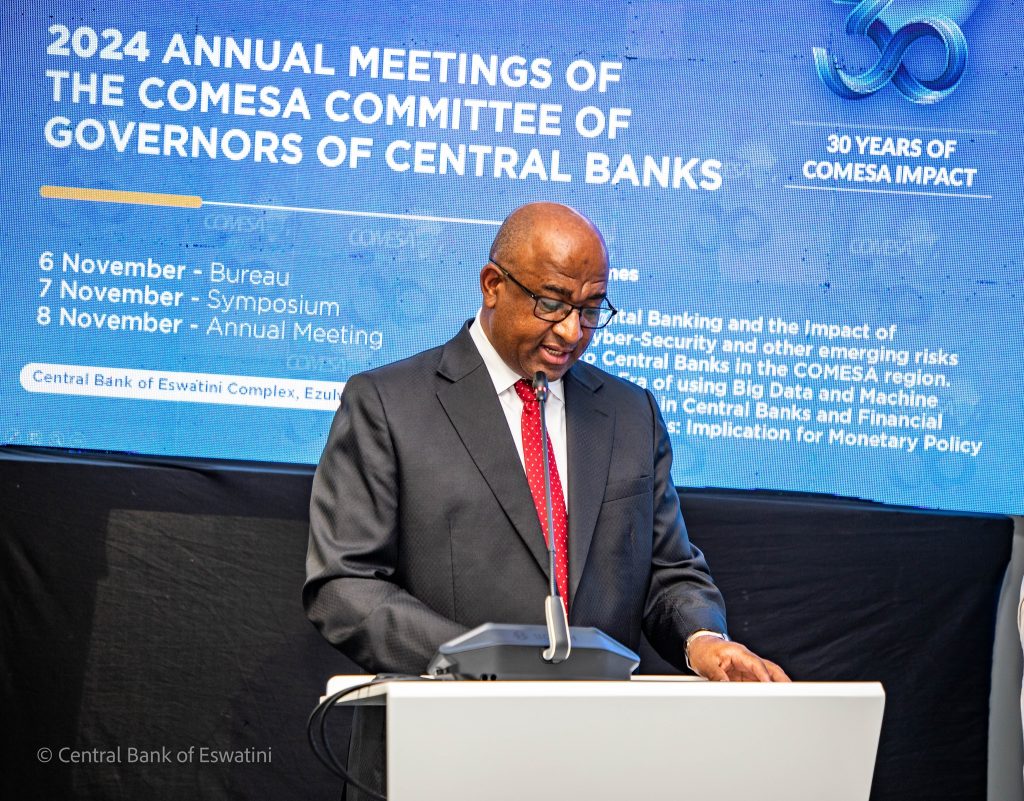
By Delisa Thwala
The Central Bank of Eswatini (CBE) together with the monetary policy consultative committee have reduced the discount rate from 7.25% to 7.0%.
This was announced by CBE Governor Dr Phil Mnisi during his Monetary policy statement address, held on Friday afternoon. A reduction in the interest rate, from its previous level of 7.0%, generally means a more favourable borrowing environment for individuals and businesses in Eswatini.
“The Central Bank of Eswatini (Bank), together with the Monetary Policy Consultative Committee (MPCC) held a meeting to consider the appropriate monetary policy stance.
Taking into consideration relevant global, regional, and domestic economic factors; as well as the price and financial stability mandate, the Bank decided to reduce the discount rate to 7.0%,” said the Governor.
This may translate into lower borrowing costs, a decrease in the interest rate makes it cheaper to borrow money, potentially leading to increased investment and spending.
It could also speak to increased liquidity where lower interest rates may encourage financial institutions to lend more money, increasing the overall amount of money circulating in the economy.
RELATED: CBE ensures seamless transactions in South Africa
Mnisi highlighted that the CBE’s interest rate reduction is expected to lead to banks lowering the prime lending rate to 10.75%. He said lower interest rates can stimulate the economy by encouraging businesses to borrow and invest more.
This can lead to job creation, higher productivity, and economic growth.
Worth mentioning is that in September this year, the CBE lowered the interest rate to 7.25% on September 21, 2024, a 25 basis point reduction from the previous rate of 7.5%. The CBE made this decision to support economic recovery and job creation.
Mnisi said banks are expected to reduce the prime lending rate on loans extended to individuals and businesses until the next monetary policy meeting.

This is good news for consumers, as it likely means lower interest rates on mortgages, car loans and credit cards, making it more affordable to borrow and spend.
According to economists, interest rate cuts will have a positive impact on consumer spending. With more money left in their pockets after debt repayments, consumers may be more inclined to spend on goods and services, which can benefit businesses across various sectors.
This is particularly relevant for small and medium-sized enterprises (SMEs), which cater to a local customer base.
Improved consumer sentiment can lead to a boost in sales and revenue generation. Furthermore, when the CBE lowers interest rates, it becomes cheaper for businesses to take out loans. This can have a domino effect on various aspects of companies’ operations.
With lower interest rates, the overall cost of repayment becomes more manageable, freeing up valuable cash flow that can be reinvested back into businesses.
This can be particularly advantageous for SMEs in the country, which may be looking to expand their operations, invest in new technology or even hire additional staff.
Economists reckon that lower interest rates can stimulate the overall economy. Businesses are more likely to borrow and invest when the cost of borrowing is lower.
RELATED: CBE calls for familiarization with the new E50 commemorative note
This increased investment leads to job creation, higher productivity and ultimately, economic growth. Increased business activity across various sectors creates opportunities for collaboration and fosters a dynamic business ecosystem.
In his statement, the governor highlighted that domestically, economic activity as measured by the quarterly gross domestic product grew by 7 per cent year-on-year (seasonally adjusted) in the fourth quarter of 2023, following a revised growth of 6.8 per cent in the third quarter.
He stated that the primary sector contracted by 5.8 per cent in the fourth quarter of 2023, compared to a 1 per cent growth in the previous quarter.
The contraction was due to a decline in forestry and animal production. The secondary sector contracted by 1.5 per cent in the fourth quarter of 2023, from a growth of 1.6 per cent in the third quarter, while the tertiary sector grew by 11.9 per cent in the fourth quarter of 2023, following an 11.6 per cent growth in the previous quarter.




